An Affair with Sally
I have no idea why Salamander Reef was named such – unlike nearby Four Foot Rock and Twenty Foot Rock – but I do remember plenty of stuff written about the fish-rich waters near Townsville’s Cape Cleveland back in the early eighties. That was before my love affair with the rocks and their garnishing corals began in the dying years of the same decade.
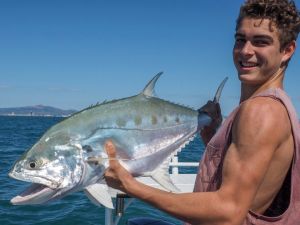
Alan Zavodny wrote a heap about the Salamander Reef complex stretching from the tip of the Cape, encompassing a series of rocks including Two Foot, Four Foot and another, much bigger, piece of hard stuff not surprisingly referred to as Twenty Foot Rock.
Meanwhile, Dale Weldon also wrote his diary pieces for Fish & Boat magazine on a monthly basis during the late eighties (a tackle store roundup, I think it was) and he nearly always told of fish from Salamander Reef.
And I read with great interest as the late, great Malcolm Florence described schools of pelagic species in abundance near ‘Sally.’ He penned stuff about queenfish so thick in numbers, they could almost be walked upon. Florence went on to write of enormous Spanish mackerel and a funny little fish called a scad or mad fish – something as foreign as could be to a fresh-faced teenager from the south who thought he knew plenty about what he could expect in fishing utopia.
I was as wrong as could be and had plenty to learn about tropical fishing, but now nearly 35 years on, I can profess to knowing a whole lot more about Sally, perhaps the most popular inshore hotspot within Townsville waters.
Finding Sally
Bouncing precisely 20 kilometres or 11 nautical miles across a relatively shallow Cleveland Bay (8 meters deep at best) lands a Sally bound angler pretty much below the Cape Cleveland lighthouse. Another 6 or so kays at close enough to 86 degrees, this undertaken at low tide, and the same angler should be confronted with a couple of rocky lumps breaking the oceans surface, the reef rising out of about 18–20 meters of blue stuff – depending on tide.
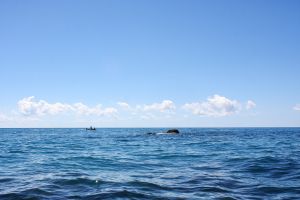
Pre affordable GPS, experienced anglers would line up Four Foot Rock with a small and easily identifiable rocky beach on the eastern flank of Cape Cleveland, the beach appearing north or slightly to the right of Twenty Foot Rock. Then they’d motor in an easterly direction positioning a distant Cape Pallarenda headland pretty much centre between Cape Cleveland and Magnetic Island. And keeping that line, should an average angler’s thumb on their outstretched arm cover the visible gap between the cape and the island, they would most often find the southern rock of Sally just a good cast away.
This primitive but effective method was always best undertaken at low tide when rocks were more readily visible – and was easier still when any sort of sea, other than millpond conditions, encouraged waves to break over the rocks.
I do like modern technology though and coordinates 19 10.879S 147 03.516E will find Salamander Reef much more easily and removes all the guess work during days of poor visibility and evening sorties.
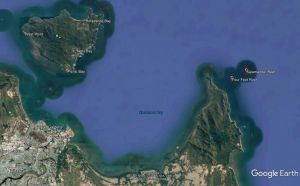
Salamander Reef is often referred to among anglers as Big and Little Sally – each title pinpointing respective and obvious rocks. The fishing around and over these rocks (remembering both are submerged during even modest high tide periods) can be, and is often subliminal. When it’s hot, there’s no better place to cast your line, but just like anywhere else in the piscatorial world, Salamander Reef can occasionally appear barren leaving experienced anglers scratching their heads.
But rest assured, there are always resident fish somewhere nearby and astute anglers will scout surrounding waters where they might well find fish – both pelagic and demersal species – schooling up to several hundred meters from the reef proper.
Although unplanned expeditions can have an uncanny knack of turning up oddball captures including snapper, mulloway and pearl perch, seasonally, the reef can be easily understood, predicted and fished well.
Queen of Salamander
As a summer option, Sally is best known in years past for giving up vast catches of queenfish when cast and retrieved surface lures or poppers enticed the ‘poor man’s marlin’ from the depths. While queenfish are partial to all manner of lures, surface fishing was, and still is at times, exhilarating and the resource in those heady days might have seemed an endless barrel of fish when huge numbers of the species were slain with little regard for future stocks.
Best surface lures include the Halco brand Rooster popper, while stick baits from the Townsville made Old Dog Lures stable seem to draw strikes when all others fail.
Big fish to better than 8 kilograms apiece were commonplace during the last decades of the 1900’s and during the early days of the sportfishing movement, the fish were relished and
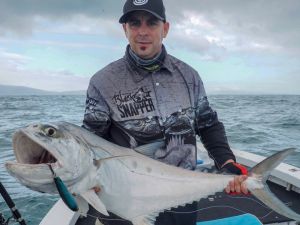
targeted on ultra light line. Queenfish of a similar calibre are still encountered from time to time near Sally but those days are becoming increasingly rare and are usually ones when conditions prove nothing but ideal for the species. Hot, balmy summer morning or late afternoon periods coinciding with a cooling 15 knots of breeze that might whip the top off a meter of chop, periodic rain squalls, the barometer perhaps dipping slightly and the scene is set for an unforgettable experience. The slab-sided speedsters will shoulder each other out of the way to engulf the lure no matter how fast it is retrieved – the quicker the better!
A hungry queenfish will run into the side of the boat in an effort to chase down a well retrieved lure – I kid you not. The fight is a spectacular and dogged one often punctuated with spectacular aerial displays before the fish is subdued – hence the analogy, ‘Poor man’s marlin.’
Often difficult to handle, a queenfish is best de-hooked with a long nose set of pliers while still in the water or if to be retained, it should be tailed or gaffed, whacked over the noggin and bled immediately before being brought on board and slipped into an ice box. Possessing a firm flesh, they present best when fresh.
Gold at Salamander
GT or giant trevally, longtail and mack tuna, grey or broad barred mackerel, lesser trevally species and barracuda are all common pelagic visitors to the Salamander Reef complex during the warm months. Meanwhile, perhaps the North’s favourite inshore table fish dwells in abundance down deep.
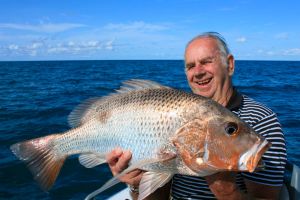
Golden snapper or fingermark are eagerly sought by Townsville and visiting anglers during the summer and early autumn months, particularly during the still summer evenings surrounding the new or dark moon periods. Live squid baits scooped up in fine mesh nets and sentenced to a short life when pinned on a hook and plummeted back to the bottom is a near certain method to attract a nearby fingermark.
Meanwhile, switched on anglers might troll deep diving minnow style lures close to the structure enticing fingermark from their lair, or drop any of an increasing array of soft plastic offerings to the bottom where a draw and sink method might fool fish on a regular basis. The locally made GIMP brand soft vibe style lure is incredibly effective and considered a must have in the tackle box many fingermark devotees.
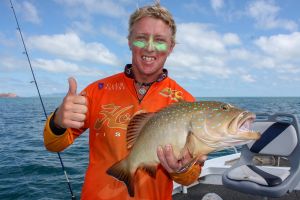
Expect fingermark using these techniques but don’t fall out of the boat when a fat coral trout grabs the bait or lure!
Mack Time at Salamander
Salamander Reef has been the scene of a bucket load of incredible mackerel catches since I first chanced my casts in her waters all those years ago and a bunch of veteran anglers have bent my ear with tales of years past. They tell of monster mackerel to better than 40 kilograms caught at and near Sally, but my first winter season back in ‘86 gave up just one paltry midget size Spaniard of nothing better than a couple of kilograms.
My great mate Peter Carbery and I fished at least twice weekly trolling wolf herring, hairtail, garfish, split tail mullet and pilchards – for absolutely zip! We thought we were doing everything right but still didn’t nail a decent mackerel till the following summer when I fluked an unseasonal fish of exactly14 kilograms on light 4-kilogram line after leaving Salamander and passing nearby Four Foot Rock while travelling home.
I was a light line nut back then and after running over a school of big fish cruising close to the surface and in dirty water, I instinctively cast a deep diving timber Killalure astern and got the bite. That was my first.
As it turned out, Carbery and I were doing most things right that first season but the fish just didn’t show.
They turned up the next, and every season thereafter… and Townsville fishers rejoiced!
Generally, Salamander gives up enough trophy size Spanish mackerel each winter and spring even though occasional fish might be caught year round. A trolled wolf herring pinned to any number of rigs including the popular Chin Guard system is a sure way to fool the big fish while live baits of fusilier, small trevally and legal-size (50cm) doggie mackerel can be just as effective.
Baits allowed to drift in any sort of current or suspended below a float is also an irresistible technique, one that is proven, simple and a favourite of many anglers. Pilchard and garfish baits pinned to razor sharp ganged hooks and a short wire trace is just the trick and reels must be set in gear before the fish strikes.
It is not necessary or advisable to free-spool a hungry mackerel and in fact preferable to have the hooks set immediately, the resistance of a pre-set drag doing the job nicely.
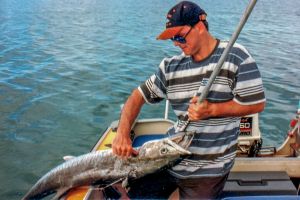
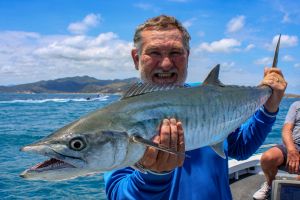
Each year I watch as anglers attempt to allow a mackerel to run before setting the hooks. Most often this results in missed opportunities. If you’re adventurous, certainly free-spool a striking mackerel but make sure the camera’s rolling and the guy behind it can control his hysterics – your burnt thumbs and accompanying antics will be worth a million hits on YouTube.
Making tides leading up to a new or dark moon is preferred by experienced anglers, though fish are encountered regularly enough on equivalent tides during the full moon period to warrant the effort. A peaking high tide or flat low tide coinciding with dawn or dusk ensures the equation just that little more reliable.
Salamander has it all
Golden and diamond trevally, small and large mouth nannygai, gold spot cod, coral trout, grassy emperor and oddities including snapper and mulloway are all bottom dwelling possibilities during the cooler months while
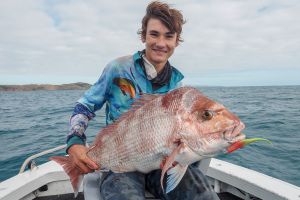
billfishing enthusiasts might try Sally’s waters from time to time.
I caught my first couple of marlin in waters between Salamander Reef and Four Foot Rock, both accidentally while chasing mackerel and I’ve seen a few pop their marlin cherry there since!
Tunas, both bluefin and mack tuna can be encountered in numbers – mack tuna year-round and bluefin (longtail) most abundant throughout spring and well into summer – while scad, leaping bonito and dart can abound at times and provide a preferred food source for big mackerel.
Sally is certainly worth getting to know – just treat her right and she’ll be good to you.
19 10.879S 147 03.516E
Anglers are reminded that a Great Barrier Reef Marine Park Yellow Zone blankets Salamander Reef and respective restrictions should be adhered to.
